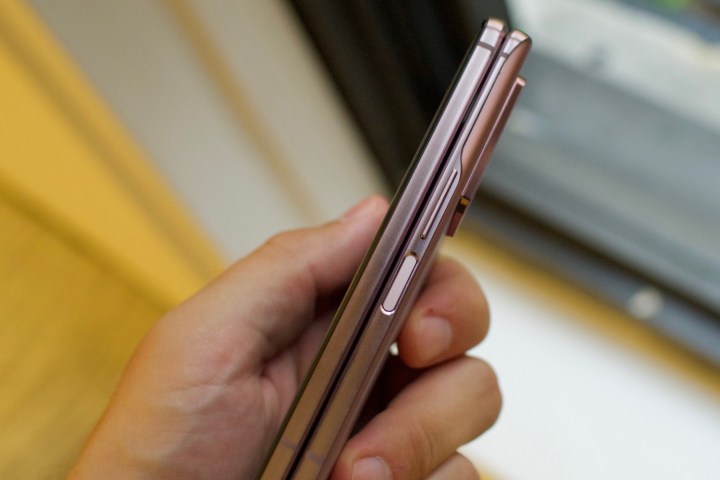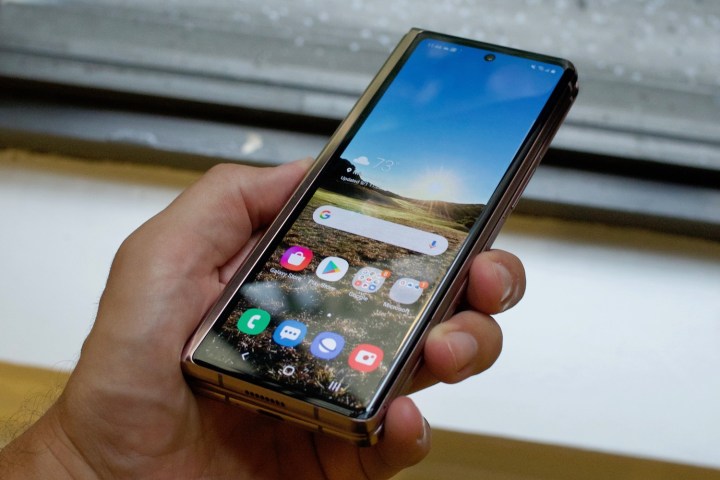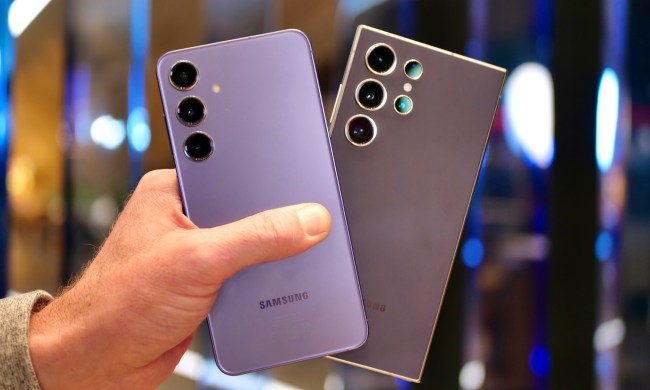The Samsung Galaxy Z Fold 2 is Samsung’s latest (and arguably greatest) foldable smartphone, being the souped-up and more durable successor to last year’s Galaxy Fold. It also succeeds this year’s Galaxy Z Flip, which took the foldable smartphone format and flipped it on its head, swapping the vertical folding of the Galaxy Fold for some nifty horizontal action. It also provided a smaller, more comfortable alternative to the larger Fold, making it easier to carry around and use.
The Z Flip and the new Samsung Galaxy Z Fold 2 improve on the blueprint laid down by the original Galaxy Fold, but which one is the best Samsung foldable for 2020? In this article, we place the two devices in a rigorous head-to-head. We compare their displays, designs, performance, cameras, software, and special features, looking to see which one is the better device overall. Both are great, but only one can be Samsung’s foldable champion.
Specs
| Samsung Galaxy Z Flip |
Samsung Galaxy Z Fold 2 |
|
| Size | Unfolded: 167.3 x 73.6 x 7.2 mm
Folded: 87.4 x 73.6 x 17.3 mm |
Unfolded: 159.2 x 128.2 x 6.9 mm
Folded: 159.2 x 68 x 16.8 mm |
| Weight | 183 grams (6.46 ounces) | 282 grams (9.95 ounces) |
| Screen size | 6.7-inch Dynamic AMOLED and 1.06-inch Super AMOLED | 7.6-inch Dynamic AMOLED 2X and 6.23-inch Super AMOLED |
| Screen resolution | 2636 x 1080 pixels (425 pixels per inch) and 300 x 112 pixels (302 pixels per inch) | 2,208 x 1,768 pixels (373 pixels per inch) and 2260 x 816 pixels (385 pixels per inch) |
| Operating system | Android 10; One UI 2.1 | Android 10; One UI 2.5 |
| Storage | 256GB | 256GB, 512GB |
| MicroSD card slot | No | No |
| Tap-to-pay services | Google Pay, Samsung Pay | Google Pay, Samsung Pay |
| Processor | Qualcomm Snapdragon 855 Plus | Qualcomm Snapdragon 865 Plus |
| RAM | 8GB | 12GB |
| Camera | 12-megapixel and 12MP ultrawide rear, 10MP front | 12MP wide, 12MP telephoto, 12MP ultrawide rear, 10MP front |
| Video | 4K at 60 fps, 1080p at 240 fps, 720p at 960 fps, HDR10+ | 4K at 60 fps, 1080p at 240 fps, 720p at 960 fps, HDR10+ |
| Bluetooth version | 5.0 | 5.0 |
| Ports | USB 3.1, USB-C | USB 3.1, USB-C |
| Fingerprint sensor | Yes, side-mounted | Yes, side-mounted |
| Water resistance | No | No |
| Battery | 3,300mAh
Fast charging (15W) Qi wireless charging |
4,500mAh
Fast charging (45W) Qi wireless charging (11W) Reverse wireless charging (4.5W) |
| App marketplace | Google Play Store | Google Play Store |
| Network support | All carriers | All carriers |
| Colors | Mirror Purple, Mirror Black | Mystic Bronze, Mystic Black |
| Prices | $1,380 | $2,000 |
| Buy from | Samsung, AT&T, T-Mobile, Verizon, Amazon, Best Buy, Walmart | Samsung, AT&T, T-Mobile, Verizon, Amazon, Best Buy, Walmart |
| Review score | Hands-on | 4 out of 5 stars |
Design, display, and durability
- 1. Galaxy Z Fold 2 unfolded
- 2. Galaxy Z Flip unfolded
They may both be classed as foldables, but the Samsung Galaxy Z Fold 2 and the Galaxy Z Flip look very different. The Z Fold 2 is big and bold, taking the angular chrome design of the Note 20 and placing it in a larger foldable body. It looks impressive when unfolded, and it looks sharp and modern when folded, resembling the Note 20 and S20 with its choice of colors (Mystic Bronze and Mystic Black). It also feels satisfyingly sturdy and robust, with its newly redesigned hinge capable of staying in place at various angles.
By contrast, the Z Flip looks more like a normal smartphone, despite the ability to fold in half horizontally, so that its length (rather than its width) is cut in half. Even though it is smaller, the ability to flip it into a discreet little half-phone may be more appealing for some.
The Galaxy Z Fold 2’s inner touchscreen measures at an impressive 7.6 inches, while its cover display comes in at 6.2 inches. By contrast, the original Flip’s unfolded display is only 6.7 inches, while you’re left looking at a miniature 1.06-inch Super AMOLED screen when you fold it. People who prefer bigger screens may be left disappointed, but it’s worth pointing out that the Z Flip’s main 6.7-inch Dynamic AMOLED touchscreen offers more pixels per inch than the Z Fold 2’s. This may give it a slight edge in terms of display sharpness, although the Dynamic AMOLED 2X technology of the Z Fold 2 should mean that it’s basically just as vivid and crisp, particularly when it boasts a 120Hz refresh rate.
Both foldables are more durable than the original Galaxy Fold, which did have a number of screen issues. Each of them is fitted with Samsung’s latest Ultra Thin Glass (UTG) foldable screen technology, which has proven itself to be more durable and robust than the material used on the first Fold. They’re also equipped with tiny bristles, which are intended to clear debris away and stop dust from entering the phones. This should, in theory, make both more durable than the first Fold, though tests have shown that exposure to excess dust can be damaging for the Z Flip.
This makes sense, since both phones lack an IP68 rating, indicating that they may not be capable of coming out unscathed from submersion in water or dust. Since neither appears to have an advantage in this respect, and since both phones are aesthetically attractive in their own respective ways, we’re calling this opening round a tie.
Winner: Tie
Performance, battery life, and charging

The Samsung Galaxy Z Fold 2 and Z Flip offer flagship-level performance, although the Z Fold 2 can lay claim to having better internal specs. It runs on a Qualcomm Snapdragon 865 Plus, the same high-end processor used in the Note 20 Ultra. The Z Flip uses the Snapdragon 855 Plus, which is certainly no slouch but won’t have quite the same output as the newer processor.
This likely means that the Z Flip won’t operate quite as speedily and smoothly as the Z Fold 2, particularly when the Fold 2 houses 12GB of RAM compared to only 8GB. Both phones have the same amount of internal memory as standard, although you can buy a 512GB version of the Z Fold 2, for a higher price.
The Galaxy Z Fold 2 also has a beefier battery at 4,500mAh compared to 3,300mAh. Some of this extra capacity won’t be noticeable, due to the Z Fold 2 having a larger screen and making larger demands on its battery. Still, the difference is big enough that you will likely find that the Z Fold 2 lasts a little longer than the Z Flip before needing a recharge. Our review found that the Fold 2 lasts at least a day between charges. Another plus is that it supports fast charging at 45W, while the Z Flip only manages 15W.
Unlike in the previous round, it’s clear that the Z Fold 2 offers noticeably improved performance in this case. This is a win for the newer device.
Winner: Samsung Galaxy Z Fold 2
Camera

Here’s another instance where the Z Flip has strong specs in its own right, but the Z Fold 2 just goes one step further. Compared to the dual-lens setup of the Z Flip (a 12MP wide lens and 12MP ultrawide), it offers a triple-lens rear camera featuring a 12MP wide lens, a 12MP ultrawide, and a 12MP telephoto.
Admittedly, better camera specs don’t always result in better photos. We found the Z Flip has a versatile camera phone, capable of taking nice photos in most situations (although it struggles a little in low light, like other Samsung smartphones). We also found that its lack of a telephoto lens doesn’t particularly disadvantage it, since it’s capable of taking good shots at 2x optical zoom that will suit most purposes. The Fold 2, by contrast, doesn’t seem to benefit substantially from having a telephoto lens, since it lacks optical image stabilization (OIS) and produces zoom shots that are soft compared to the main lens.
Things are also fairly even when it comes to video. Both smartphones are capable of shooting 4K video at 60fps, which is still pretty much as high-end as you can get right now (apart from the 8K capabilities of the Note 20 Ultra).
This round is a draw. The Z Fold 2 may seem better in theory, but in practice its camera is about just as good as the Flip’s.
Winner: Tie
Software and updates

The Galaxy Z Fold 2 and Galaxy Z Flip both operate using One UI 2 OS, Samsung’s own proprietary Android 10 skin. This makes one-handed use of either smartphone easier, while it also simplifies the user interface compared to One UI 1 and other Android 10 versions. It’s also one of the more vibrant and colorful Android systems, while offering a high level of customization.
The Z Fold 2 and Z Flip aren’t likely to receive new updates as quickly as other phones, since Samsung hasn’t always been the quickest in rolling out new versions of One UI 2. That said, it has been getting better at this recently, so it’s not as bad as some Samsung detractors would have you believe.
This round is an obvious tie, since both phones run on identical software.
Winner: Tie
Special features

The Samsung Galaxy Z Fold 2 and Galaxy Z Flip are both foldables, so their main special features is the ability to fold in half. The only difference is that the Z Fold 2 folds across a vertical axis (so that its width cuts in half), while the Z Flip folds across a horizontal one (so that it becomes half as tall). It’s arguable as to which way is more “special,” although the size of the Z Fold 2 effectively means that it’s a tablet and smartphone in one.
The Z Fold 2 also offers a minor upgrade with its folding mechanism. Its hinge can stop at different angles, allowing you to prop it up in a variety of postures, much like a laptop. It also supports 5G as standard. The Z Flip doesn’t offer this, although it can be bought as a 5G version (which comes with the more powerful Snapdragon 865 Plus processor), for an extra $100. This gives the Z Fold 2 another slight advantage, preparing it for a time when 5G networks cover most developed areas of the world.
Taking the fact that it’s a tablet-smartphone hybrid, and the fact that it supports 5G out of the box, we’re declaring this round a slim victory for the Z Fold 2.
Winner: Samsung Galaxy Z Fold 2
Price and availability
The Galaxy Z Fold 2 starts at $2,000. It’s available to order from Samsung and will be supported by all major carriers. The Galaxy Z Flip starts at $1,380, while the Z Flip 5G can be had at around $1,450 from places like Best Buy, T-Mobile, and AT&T (it’s officially priced at $1,500).
Overall winner: Samsung Galaxy Z Fold 2

It may be about $500 more expensive, but the Samsung Galaxy Z Fold 2 is a better smartphone overall than the Galaxy Z Flip. Both phones look great in their own respective ways, while they both have strong cameras and user-friendly software. However, the superior performance and battery of the Z Fold 2 puts it ahead of the Z Flip, while the default support for 5G and its ability to be used as a tablet also give it an advantage.
Of course, $500 is a considerable amount of money, so we have to make it clear that the Z Fold 2 wins only just, and only because it’s a more advanced smartphone overall. If you take price more into account, then you could just as easily say that the Z Flip is Samsung’s best foldable.





